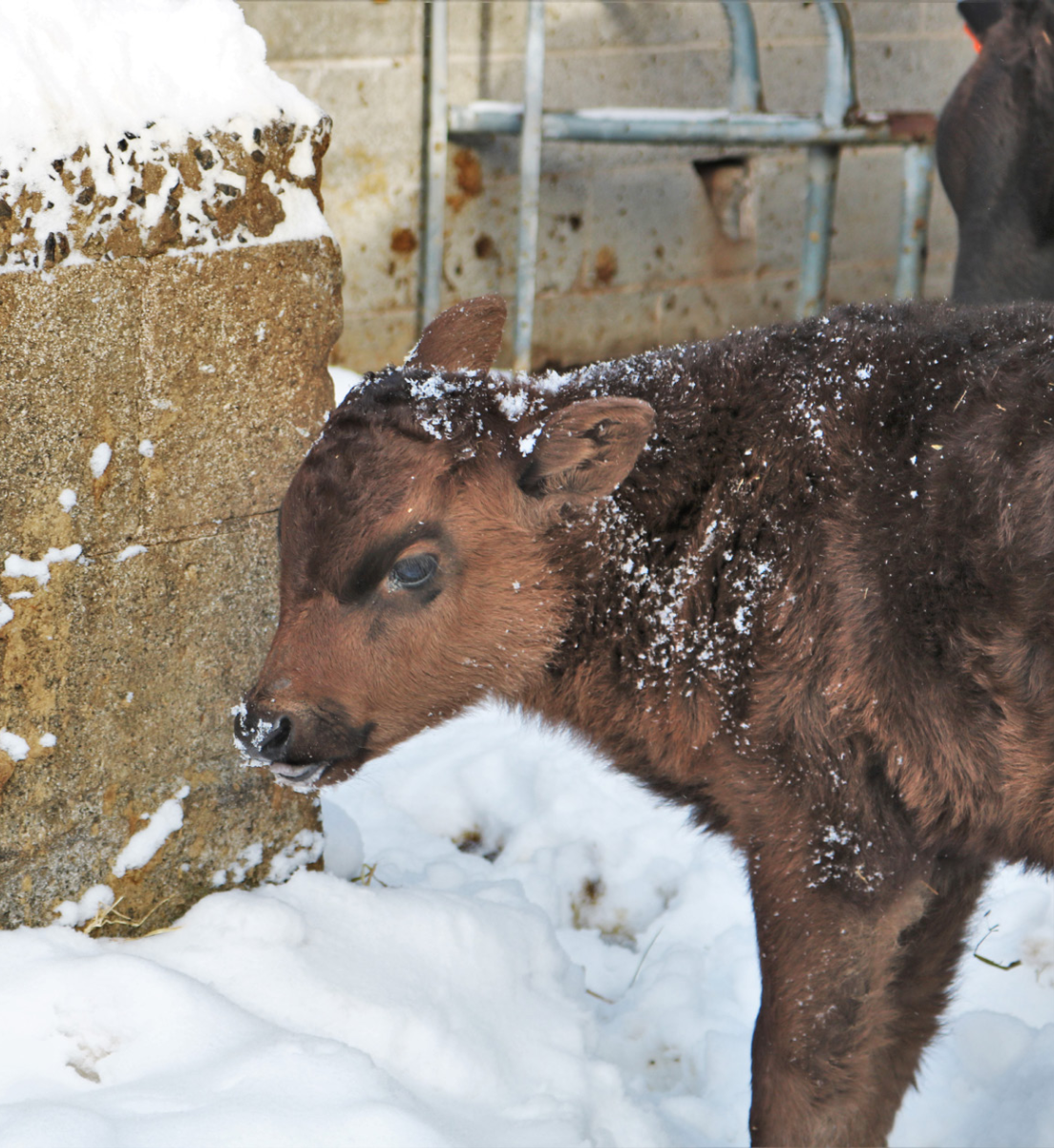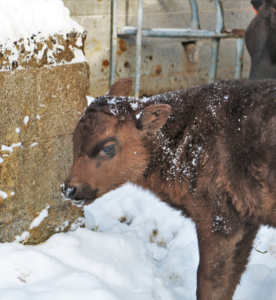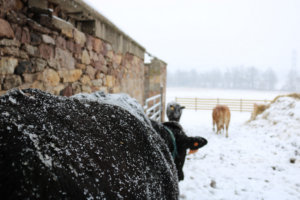
The Impact of Cold Stress
Now that winter is here in the northern hemisphere, beef herd operations are shifting their focus to planning for the challenges that are accompanied by the cold, wet, and windy weather. Just as the heat of summer can pose problems for cattle, so can the stress of winter due to a number of factors such as low temperatures, rain, snow, mud, feed quality and/or quantity, and poor body conditions. Cattle can typically manage and be extremely tolerant of cold conditions, however, there is a certain of amount of knowledge, common sense, and experience needed by the manager to see a herd through winter.
It is important to understand lower critical temperature (LCT) when determining whether or not cattle are able to handle various types of cold weather. LCT is the temperature at which maintenance requirements increase to the point where animal performance is being negatively impacted. A standard rule of thumb often lists the LCT as 18-20 degrees Fahrenheit. Critical temperatures, however, can be influenced by the type of coat worn by the cattle. In short, this means that cattle must use more energy to keep themselves warm and maintain themselves when the temperature dips below their critical temperature. For cattle wearing a summer coat or a wet coat, their critical temperature is 59 degrees Fahrenheit; cattle wearing a fall coat have a critical temperature of 45 degrees Fahrenheit; cattle wearing a winter coat have a critical temperature of 32 degrees Fahrenheit; and cattle wearing a heavy winter coat have a critical temperature of 18 degrees Fahrenheit. It is important to be mindful of these benchmarks because cattle can be greatly impacted. For example, cattle in some locations may still be in their summer coats when an early blizzard strikes, or cattle may experience a cold rain in the dead of winter, rendering their winter coat useless due to the loss of insulation.
Calves are even more vulnerable when it comes to cold, wet, windy weather. The LCT for calves is approximately 60 degrees Fahrenheit, however when rain and snow are added the LCT increases closer to 70 degrees Fahrenheit. It is much easier to visually identify a calf struggling with cold temperatures than it is with a grown cow. To gain insight into the severity of the cold stress and determine whether hypothermia has set is, rectal temperature is the most accurate method for a calf. There are two types of hypothermia that effect calves during cold weather temperatures: exposure and immersion. Exposure hypothermia involves a steady loss of body heat in a cold environment as a result of respiration, evaporation, poor body condition, poor protection from weather, and poor hair coat. Immersion hypothermia involves rapid loss of body heat as a result of a wet, saturated coat in a cold environment. Immersion hypothermia is most commonly seen immediately following birth.
So, what can be done to protect cattle and calves when cold temperatures settle in sooner than expected? Providing shelter, or wind breaks, is an easy solution to offering cattle protection from the elements and lowering wind-chill when it is cold, wet, and windy. Providing a well-ventilated building, stack of large bales, woods and/or brush, fence rows, and hollows are all ways to offer quick protection for cattle when the weather changes. In addition, muddy conditions should be minimized as much as possible because it acts similar to a wet coat: it greatly reduces the insulation ability. In areas heavily occupied by cattle, use bedding to help keep the area dry and clean and add a layer of protection between the animal and muddy or frozen ground. This leads to better managed cow comfort and one less stressor for the herd to endure throughout the winter months. Providing plenty of dry bedding is just as important, if not more, for calves because they spend upwards of 75% of their time lying down. Just as mature cows are affected by wet and muddy conditions, so are calves–however calves are at a greater risk of hypothermia. Dry, clean spaces for calves will aid in the newborn calf’s ability to maintain a dry coat and insulation of body heat. For calves needing a little extra help to maintain insulation, calf blankets may be utilized or a warming box.
 Another focus during cold weather temperatures should be feeding programs. Depending on the type of cold temperatures and the duration the weather, managers may need to adjust their cattle’s nutrition, especially for cows in late gestation. As temperatures drop, it is normal for cattle to eat more to keep up with the extra energy they are expelling. Cattle in winter months may benefit from an increase in the amount of hay available and supplements with grain or a higher quality forage, however speak with a nutritionist prior to making any large changes in a feeding program. For cows in late gestation during cold winter months, protein, energy, and supplemental fat all play a crucial role in setting a newborn calf up for a good start. Colostrum is vital to newborn’s nutrition because it is filled with various immunoglobulins and other substances which provide a calf with its first immunity against infectious agents. In addition, be sure that cattle have ample water supply that is not frozen or frigidly cold. If cattle are not drinking, their feed intake will lower, making it more difficult for cows to meet their energy requirements.
Another focus during cold weather temperatures should be feeding programs. Depending on the type of cold temperatures and the duration the weather, managers may need to adjust their cattle’s nutrition, especially for cows in late gestation. As temperatures drop, it is normal for cattle to eat more to keep up with the extra energy they are expelling. Cattle in winter months may benefit from an increase in the amount of hay available and supplements with grain or a higher quality forage, however speak with a nutritionist prior to making any large changes in a feeding program. For cows in late gestation during cold winter months, protein, energy, and supplemental fat all play a crucial role in setting a newborn calf up for a good start. Colostrum is vital to newborn’s nutrition because it is filled with various immunoglobulins and other substances which provide a calf with its first immunity against infectious agents. In addition, be sure that cattle have ample water supply that is not frozen or frigidly cold. If cattle are not drinking, their feed intake will lower, making it more difficult for cows to meet their energy requirements.
While not all cold weather challenges can be controlled, a little bit of planning can go a long way in reducing the effects of cold on cows and calves. This will not only protect the herd, but will also reduce costs and improve production efficiency. Prevention of cold stress from cold weather, snow, and rain during the winter months will save money and in the long run make a herd better of because of it.




